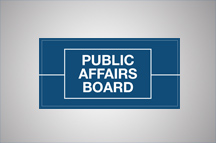By Emma Petela, Deputy Chair of the Public Affairs Board Executive Committee
Before the Association of Professional Political Consultants (APPC) merged with the PRCA earlier this month, forming the new Public Affairs Board (PAB), I had - in my capacity as Deputy Chair of the APPC - been leading an initiative to better understand our industry and the challenges it faces. As part of this process we surveyed over 80 consultants in then-APPC organisations. The objectives were: to better understand the people working in our industry and the challenges they face; to find out more about the demographics of our industry and to use this data as a benchmark to track changes; and to understand and articulate the challenges our members face.
Whilst the establishment of the Public Affairs Board, with its new expanded membership base, means that our data is by its very nature only partial, we still felt that sharing it more widely could be beneficial in starting what I hope will be a conversation about how to address some of the challenges our industry faces. We will, as mooted during the merger talks, actually be launching a fully-fledged Public Affairs Census in 2019 which will build on this year’s results.
Afterall, better understanding our members can only be beneficial in more effectively representing them. The establishment of the new Public Affairs Board - and the greater resources available to us as part of the PRCA - also means that we are best-placed to take action.
With this in mind, over coming weeks my colleagues and I will be posting a series of articles, each of which looks at a different aspect of the survey findings. We’ll post the subsequent articles on the Public Affairs Board website. In the first of these however, I wanted to offer an overview of the findings and share some of the headline demographic data.
Age
In terms of age, perhaps unsurprisingly, we find that the biggest cohort is the under-40s, who make up over 80% of respondents. The biggest single category is made up of those aged 30-39 (38% of respondents). A little over 10% of respondents said they were over 50 years old (in a future article we’ll look in more depth at this in the context of staff retention).
Gender
When it comes to gender, we find a significant slant towards male consultants by a factor of almost 2:1 (63% of respondents male vs 33% female, the remainder chose not to disclose these details). It would be interesting to see whether we see the same split when we carry out the Public Affairs Census using a bigger cohort. However, assuming it is a fair representation of the agency workforce, it highlights an issue that we as an industry need to address. Looking at the Executive Committee’s own team, it’s clear to me that we must find ways to attract more women into leadership positions - out of the 26 strong Executive Committee, only six are women. Of course this male majority is also something we observe in the wider body politic. For example, in the House of Commons there were 208 female MPs elected in 2017 compared to 442 male MPs. But that doesn’t mean we shouldn’t be making efforts to attract and encourager more women both into our industry and onto the PAB’s Executive Committee.
Location
Where are most member lobbyists based? With most member agencies headquartered in London it is hardly surprising that over 78% of respondents say they work in the capital. 8% of consultants say they’re based in Wales and less than 6% in Scotland. Just one respondent said they’re based in Northern Ireland. A further five consultants were based outside of London but not in the devolved nations. However, the growth in the importance of the regional mayoralties could well be starting to change the geo-demographics of our industry. It will be interesting to explore this in further detail in the Public Affairs Census 2019 to better understand the degree to which public affairs activity and lobbyists themselves are locating outside of their traditional strongholds of Westminster, Holyrood, Cardiff Bay, and Stormont.
Working patterns
A particular element of consultants’ working lives that we were interested in was the prevalence of home working. 22.5% told us they never work from home, and a further 57% said they do so only rarely. 12% said they worked more than one day per week from home. It will be interesting to see whether there is a growth in home working over the coming years; it’s certainly a trend which has been observed across the wider economy and which service sector offerings like lobbying should be able to readily accommodate, notwithstanding the need for consultants to attend meetings in Parliament and the devolved assemblies.
We also asked respondents about their working hours. Recent analysis from the EU’s statistics arm Eurostat found British employees worked, on average, 42 hours per week. Based on our own survey findings the majority of agency lobbyists certainly fall within this bracket: 62% say they work between 40-49 hours per week. 15% of respondents say they work between 50-59 hours per week while 5% say they work more than 60 hours per week. The future Public Affairs Census will seek to understand in more detail exactly how many hours lobbyists estimate they work (that is: how many hours they are contracted for and how many hours they actually work) and the extent to which work encroaches on leisure-time at evenings and weekends.
Further articles will analyse particular findings in a little more depth, cross-referencing answers to help us burrow down a little deeper into the data. Whilst this is just a small snapshot of our sector, I hope to see this built on over the years to allow us to make detailed insights into our industry and practices with a Public Affairs Census.














